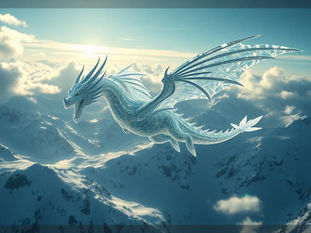
How AI Makes Images from Text: A Simple Guide
May 13
4 min read
0
1
0

Have you seen AI create art that looks like a master painted it? Or strangely real human faces that don't actually exist? That's AI image generation at work. It might seem like magic, but there's a clear process behind it. Let's break down how computers learn to create visuals from words or ideas.
Think back to what we discussed about AI learning patterns and making predictions. Image generation is similar.
Instead of predicting numbers or text, AI predicts the colors and shapes of pixels, piece by piece, to build an image. The goal is to make it look like a human created it.
What is AI Image Generation?
At its core, AI image generation is teaching computers to make pictures from nothing. This is often based on a text description you give it, or by copying a specific art style.
The AI starts by studying a huge collection of real pictures. We're talking thousands, even millions, of images. This helps the AI learn the basic look of the world – what shapes, colors, and textures are, what objects look like, how faces are structured, and more.
After this intense training, the AI can then produce completely new images. These pictures might look incredibly realistic, even if they depict something that has never existed before.
The Main AI Models Behind Image Creation
Different types of AI models are used to make images. Here are a few key ones:
GANs (Generative Adversarial Networks)
Imagine two AIs playing a game against each other. One AI (the Generator) tries to make fake images. The other AI (the Discriminator) acts like a judge, trying to spot which images are fake and which are real.
This constant competition forces the Generator to get better and better until its fake images are almost impossible to tell apart from real ones.
VAEs (Variational Auto-Encoders)
These models work by taking images and turning them into a simplified set of numbers. Then, they can use these numbers to build the image back up. This ability also lets them mix and change styles or create new images.
Diffusion Models
These are used in popular tools like Midjourney and DALL-E. Diffusion models start with random noise – like static on an old TV. Step by step, they clean up and refine that noise until a clear image appears. It's similar to watching a blurry photo slowly come into focus.
Working with diffusion models, especially with powerful tools like Midjourney, can involve a lot of steps and refinement. To make this easier and faster, consider exploring the Midjourney Automation Suite from TitanXT, which can help streamline your image generation process.
How Does AI Know What to Draw from Text?
So, how does the AI understand a request like "a red car driving on a mountain road"?
It works because these AI models are trained on huge datasets where images are paired with text descriptions. The AI learns which words go with which visual elements. It connects the concept of "car" with images of cars, "red" with the color red, and so on.
When you type your prompt, the AI processes the text first. It turns your words into a representation the image generator can understand. Then, the generation model uses this information to create the picture you asked for.
Important Things to Consider
While AI image generation is amazing, it's not perfect and brings up important points:
Sometimes the AI doesn't fully understand the prompt. It might create strange details or inaccurate pictures.
There are questions about copyright. If AI is trained on many artists' work, does the AI-created image belong to the AI owner, the original artists, or someone else?
Sadly, this technology can be used to make misleading or fake images or videos. Using this tech responsibly is very important.
Making great images with AI like Midjourney often requires experimentation and understanding how prompts influence results. Tools that help manage your prompts and generated images can be a big help. Check out the Midjourney Automation Suite for features designed to make managing your Midjourney projects simpler.
Using AI Image Generation in the Real World
AI image generation is already used in many different fields:
Art and Design: Artists use it to quickly come up with ideas and visualize concepts.
Fashion: AI can help generate new clothing designs or patterns.
Healthcare: It creates fake medical scans (synthetic data) to train doctors and medical systems without compromising patient privacy.
Entertainment: AI makes characters, backgrounds, and visual effects for video games and movies.
If you work in any field that uses visuals, automating parts of your image creation process with AI could save significant time. Learn how the Midjourney Automation Suite from TitanXT can help streamline your workflow and boost creativity.
Conclusion
We've seen that AI isn't just for analyzing data or making text. It can create brand new visual content based on our instructions.
Understanding how these models work is key to using them effectively and thinking about the issues they raise.
There’s much more to explore about how computers interact with the visual world. In the next part, we'll look at how AI understands videos and moving images.






